You’ll discover that large outdoor pot plants can completely transform your garden space, creating stunning focal points and defining distinct zones. Whether you need privacy screening, tropical ambiance, or year-round structure, the right combination of container plants can achieve your landscaping goals. From towering bamboo clusters reaching 15-20 feet to dramatic Mediterranean citrus trees bearing fragrant blooms, these seven versatile options offer practical solutions for any outdoor setting.
Contents
- 1 Tall Bamboo Clusters for Natural Privacy Screens
- 2 Statement Palm Trees in Decorative Containers
- 3 Cascading Mixed Flower Arrangements
- 4 Sculptural Succulents and Desert Plants
- 5 Evergreen Topiary Designs for Year-Round Structure
- 6 Fragrant Citrus Trees in Mediterranean Planters
- 7 Ornamental Grasses for Modern Garden Style
Tall Bamboo Clusters for Natural Privacy Screens
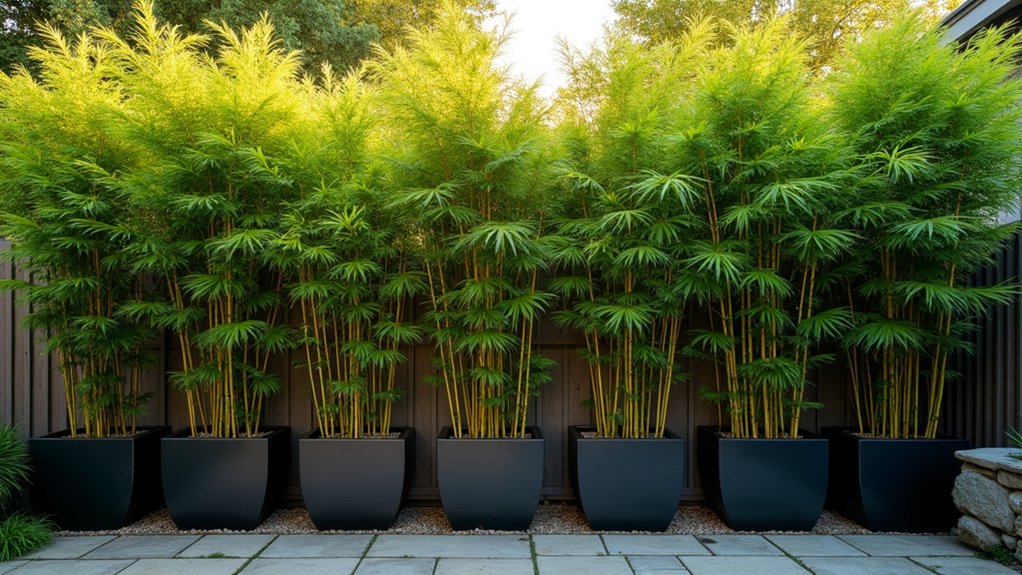
Bamboo clusters create elegant, natural privacy screens that can transform an exposed garden into a secluded sanctuary. These towering plants, which can reach heights of 20-40 feet depending on the variety, feature graceful canes topped with delicate, rustling leaves that sway with the breeze.
The dense growth pattern of bamboo stems creates an effective living wall that combines both beauty and functionality, while the vertical lines add architectural interest to the landscape.
Growing Conditions:
- Full sun to partial shade, with protection from strong winds
- Regular watering to maintain consistently moist but not waterlogged soil
- Well-draining, fertile soil with pH between 6.0 and 6.5
- Spacing of 3-5 feet between plants for optimal screening
- Minimum soil depth of 2 feet for proper root development
- Temperatures above 20°F (-6°C) for most hardy varieties
To maintain healthy bamboo clusters, implement a containment strategy using physical barriers or root pruning trenches to prevent unwanted spreading.
Prune out old or damaged canes at ground level during spring, and remove any dead foliage to maintain appearance.
Apply a thick layer of organic mulch annually to retain moisture and suppress weeds, while feeding with a balanced fertilizer during the growing season will promote robust growth and maintain the dense screening effect.
Statement Palm Trees in Decorative Containers
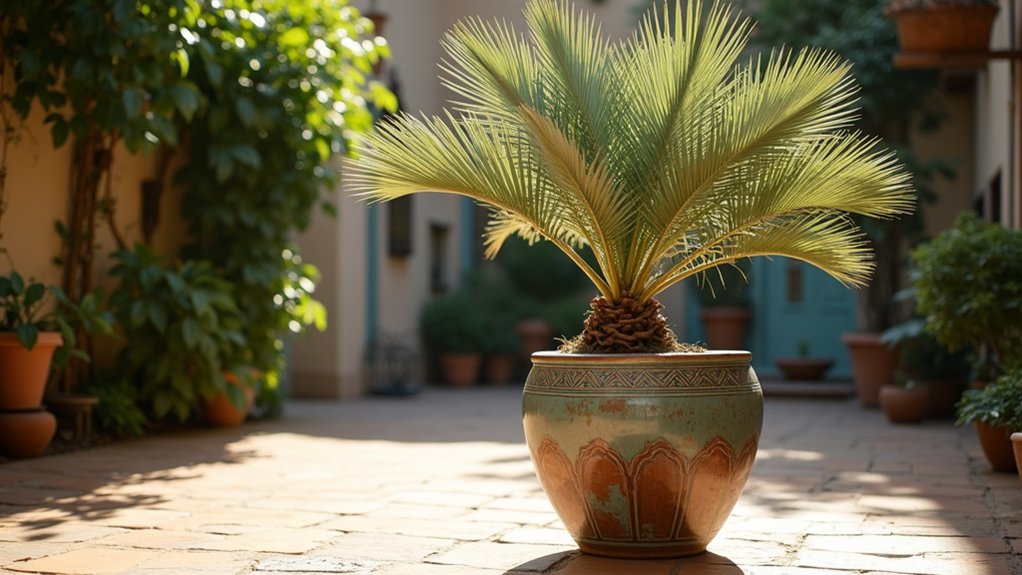
Statement palm trees in decorative containers create a bold tropical focal point in any outdoor space. These architectural plants, with their distinctive fan-shaped or feathered fronds and sturdy trunks, bring instant sophistication when housed in stylish pots.
Popular container-friendly varieties include Sago Palm, European Fan Palm, and Parlor Palm, which can range from compact 3-foot specimens to more towering varieties, making them versatile choices for different garden sizes.
- Light: Bright, indirect sunlight; most varieties tolerate partial shade but thrive in full sun
- Water: Moderate watering; allow top 2 inches of soil to dry between waterings
- Soil: Well-draining, rich potting mix with added perlite or sand
- Container: Large, sturdy pot with adequate drainage holes
- Temperature: Prefer warm conditions, 65-85°F (18-29°C)
- Humidity: Medium to high humidity levels
- Fertilizer: Slow-release palm fertilizer every 3-4 months during growing season
Regular maintenance for containerized palms includes pruning dead or yellowing fronds at the base, rotating the container quarterly for even growth, and repotting every 2-3 years or when roots become crowded.
Inspect regularly for spider mites and scale insects, especially under fronds, and clean the leaves periodically with a damp cloth to remove dust and maintain their glossy appearance.
During winter months in colder regions, consider moving containers to protected areas or indoors to prevent frost damage.
Cascading Mixed Flower Arrangements
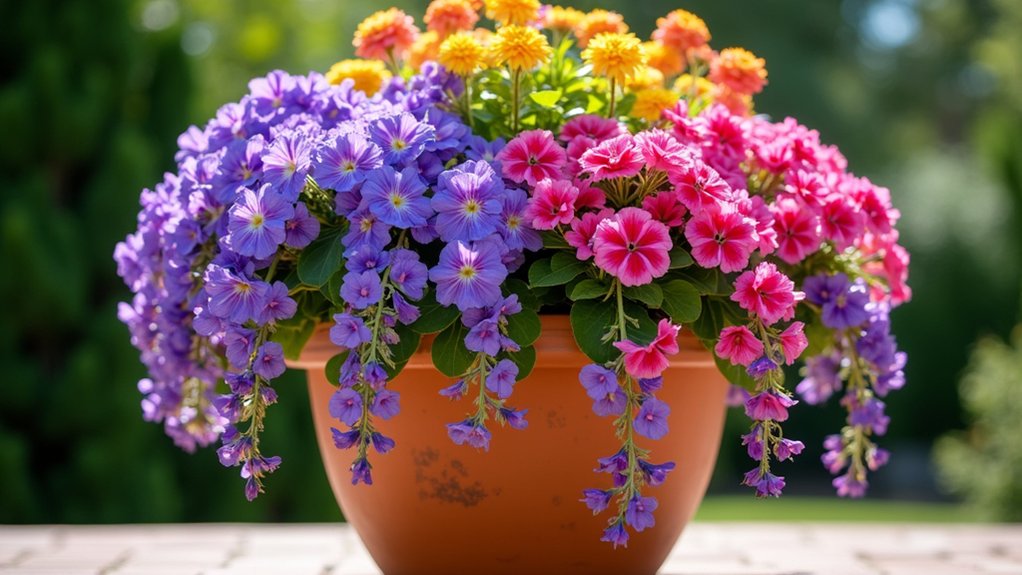
Cascading mixed flower arrangements create a dramatic waterfall effect of blooms spilling over the edges of containers, adding depth and visual interest to any outdoor space.
These arrangements typically combine trailing plants like petunias, lobelia, and verbena with upright flowers such as geraniums or lantana, creating layers of color and texture that flow downward. When properly planned, these living cascades can extend 2-3 feet below the container rim, making them perfect for hanging baskets, wall planters, or elevated containers.
Growing Conditions:
- Full sun to partial shade, depending on flower varieties chosen
- Well-draining potting soil enriched with organic matter
- Container depth of at least 12 inches to accommodate root systems
- Consistent moisture level, never allowing soil to completely dry out
- Weekly fertilization during growing season with balanced liquid fertilizer
- Protection from strong winds that could damage trailing stems
- Minimum 6 hours of direct sunlight for most flowering varieties
Regular deadheading of spent blooms and periodic trimming of leggy stems helps maintain the cascade’s shape and encourages continuous flowering throughout the season.
To prevent the arrangement from becoming one-sided, rotate containers weekly, allowing all plants equal light exposure. When stems become too long or sparse, pinching back growth tips will promote bushier growth and help maintain the desired cascade effect.
Strategic pruning of faster-growing plants prevents them from overwhelming slower-growing companions, ensuring a balanced and harmonious display.
Sculptural Succulents and Desert Plants
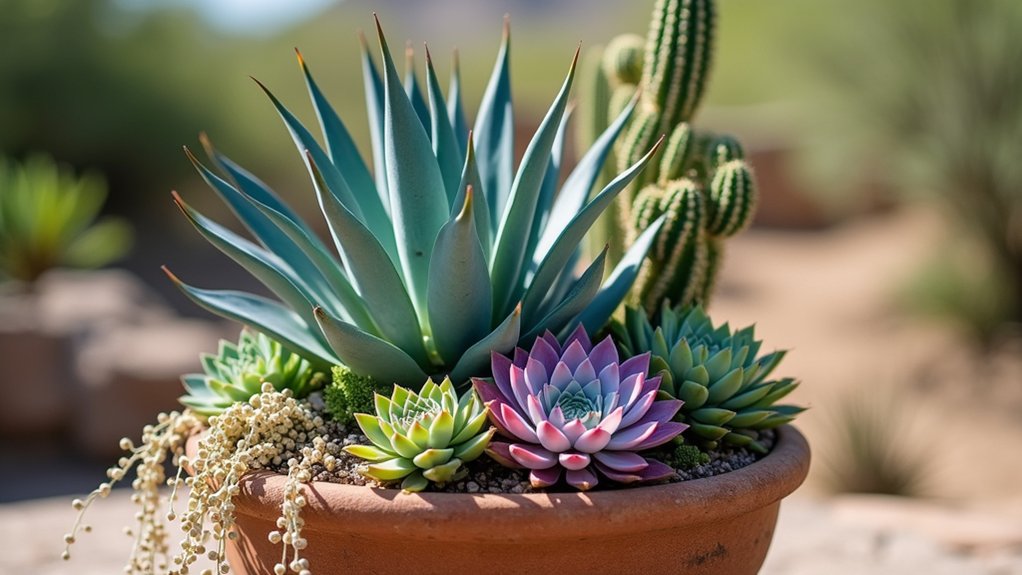
Sculptural succulents and desert plants bring dramatic architectural elements to outdoor container gardens with their striking forms and unique textures. From the towering vertical lines of snake plants to the geometric rosettes of echeverias and the sprawling arms of desert cacti, these plants create living sculptures that serve as natural focal points.
Their thick, fleshy leaves and stems, evolved to store water, provide year-round interest and come in an array of colors from soft blue-grays to vibrant purples and deep greens.
- Full sun to partial shade, with morning sun ideal in hot climates
- Well-draining, gritty soil mix specifically formulated for succulents
- Minimal watering – allow soil to dry completely between waterings
- Protection from frost and extended periods of rain
- Container must have drainage holes
- Temperatures between 60-80°F (15-27°C)
- Low humidity environment
- Space to accommodate growth and spread
Regular maintenance of sculptural succulents and desert plants focuses on preventing common issues rather than frequent care.
Remove any dead or yellowing leaves promptly to prevent rot from spreading, and rotate containers quarterly to ensure even growth. During the growing season, prune leggy growth to maintain desired shapes and remove offsets (pups) for propagation.
While fertilization isn’t crucial, applying a diluted cactus fertilizer once during spring can support healthy growth. Inspect regularly for pests like mealybugs and scale, treating immediately if found.
Evergreen Topiary Designs for Year-Round Structure
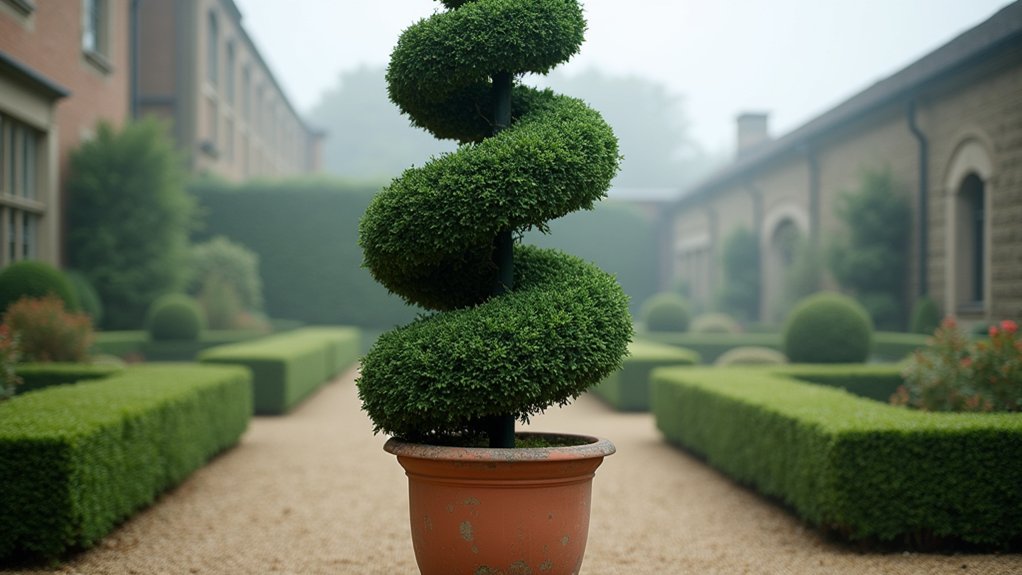
Evergreen topiary designs serve as living sculptures in the garden, providing architectural interest and structure throughout all seasons. These carefully shaped plants, typically created from boxwood, yew, or holly, can be crafted into various geometric forms, spirals, animals, or classic cone shapes.
The dense foliage and slow growth rate of these evergreens make them ideal candidates for maintaining crisp, defined shapes that anchor garden spaces and create visual focal points.
Growing Conditions:
- Full sun to partial shade, with protection from harsh afternoon sun
- Well-draining soil rich in organic matter
- Soil pH between 6.0 and 7.0
- Regular, consistent moisture without waterlogging
- Spacing of 2-4 feet between plants, depending on mature size
- Protected location away from strong winds
- Hardiness zones 5-8 for most common topiary species
Maintaining topiary designs requires regular attention to preserve their sculptural forms and health. Trim the plants every 4-6 weeks during the growing season using sharp, clean shears, and always cut back to a leaf or branch junction to prevent die-back.
Shape gradually rather than removing large amounts at once, and consider using guide wires or frames for complex designs. Apply a slow-release fertilizer in spring, and monitor for signs of pests or disease, particularly spider mites and leaf spot, which can compromise the dense foliage needed for attractive topiary forms.
Fragrant Citrus Trees in Mediterranean Planters
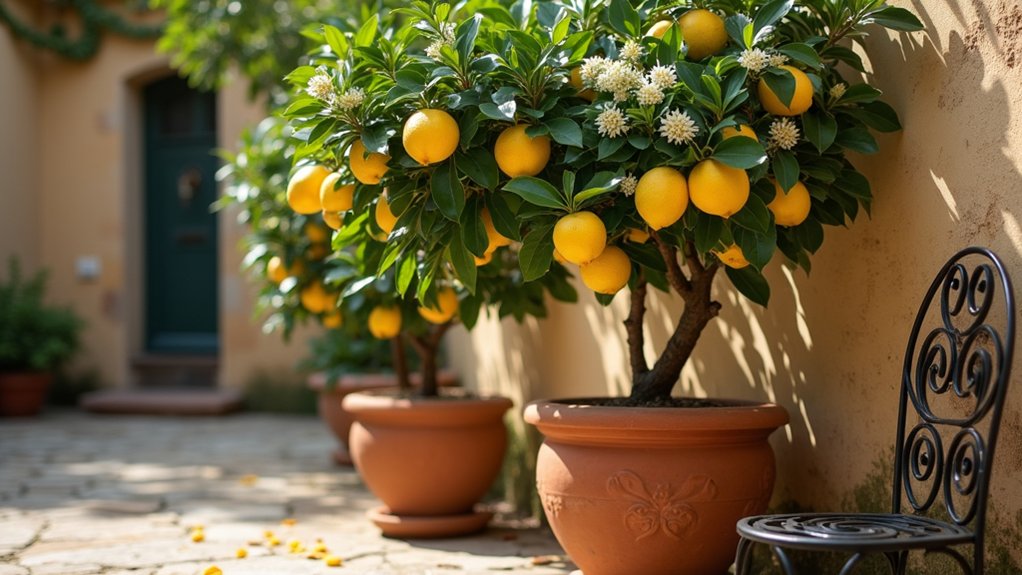
Mediterranean-style planters filled with fragrant citrus trees create an elegant and sensory-rich focal point in any outdoor space. These decorative containers, often made of terracotta or weathered ceramic, complement the glossy dark green foliage and vibrant fruits of lemon, lime, or orange trees.
The combination evokes a sun-drenched European courtyard aesthetic while providing both ornamental appeal and edible harvests, with sweet-smelling blossoms that perfume the air throughout the growing season.
Growing Conditions:
- Full sun exposure (6-8 hours daily)
- Well-draining potting mix enriched with organic matter
- Consistent moisture but never waterlogged
- Protected location away from cold winds
- Minimum winter temperatures above 40°F (4°C)
- Container size at least 20 inches in diameter
- Regular feeding with citrus-specific fertilizer
Regular pruning to maintain shape and size is essential for containerized citrus trees, along with monitoring for pest issues like scale insects and spider mites.
During the growing season, remove any crossing branches and water-sprouts to improve air circulation. Repot every 2-3 years in early spring, trimming back approximately one-third of the roots and refreshing the soil.
Moving containers indoors or to a protected area during frost periods will ensure survival in colder climates.
Ornamental Grasses for Modern Garden Style
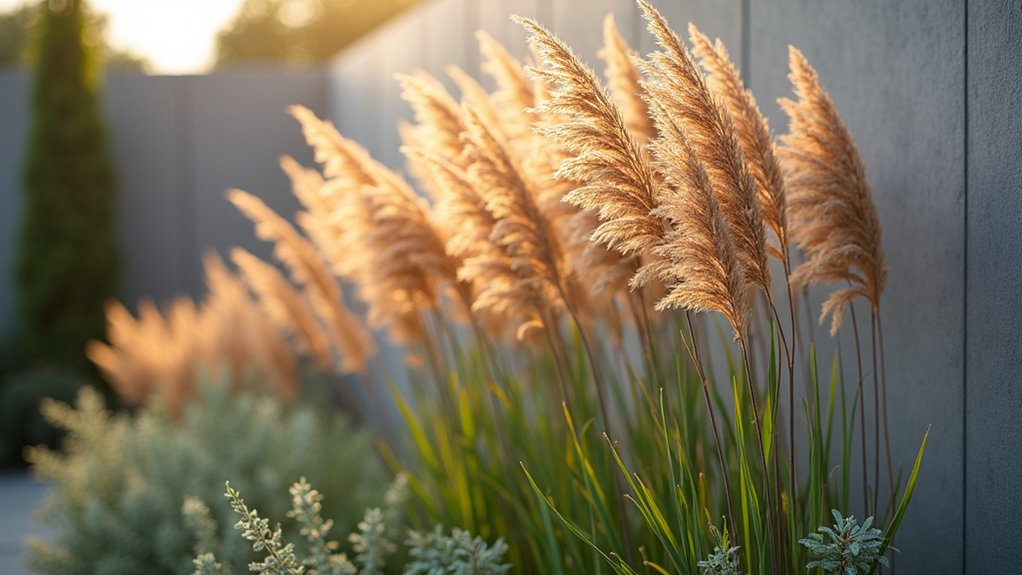
Ornamental grasses add dynamic movement, texture, and year-round interest to modern garden designs.
These versatile plants range from compact varieties reaching just a few inches tall to towering specimens that can grow up to 8 feet or more. Their slender leaves catch the breeze, creating a natural rhythm in the landscape, while their feathery plumes and seed heads provide visual interest from summer through winter. Many varieties also offer striking color variations, from deep greens to blues, reds, and variegated patterns.
Growing Conditions:
- Full sun to partial shade, with most varieties preferring at least 6 hours of direct sunlight
- Well-draining soil with moderate fertility
- Moderate watering needs; established plants are typically drought-tolerant
- Spacing of 2-4 feet between plants, depending on variety
- USDA hardiness zones 4-9 for most varieties
- Tolerant of various soil pH levels, from slightly acidic to neutral
Regular maintenance of ornamental grasses focuses primarily on annual cutting back and division every few years.
Cut back deciduous grasses to about 6 inches above ground level in late winter or early spring before new growth emerges. Evergreen varieties benefit from light trimming to remove dead foliage and maintain shape.
Division is typically necessary every 3-4 years when the center of the clump begins to die out or the plant becomes too large for its space. This process is best done in spring for warm-season grasses and fall for cool-season varieties.
